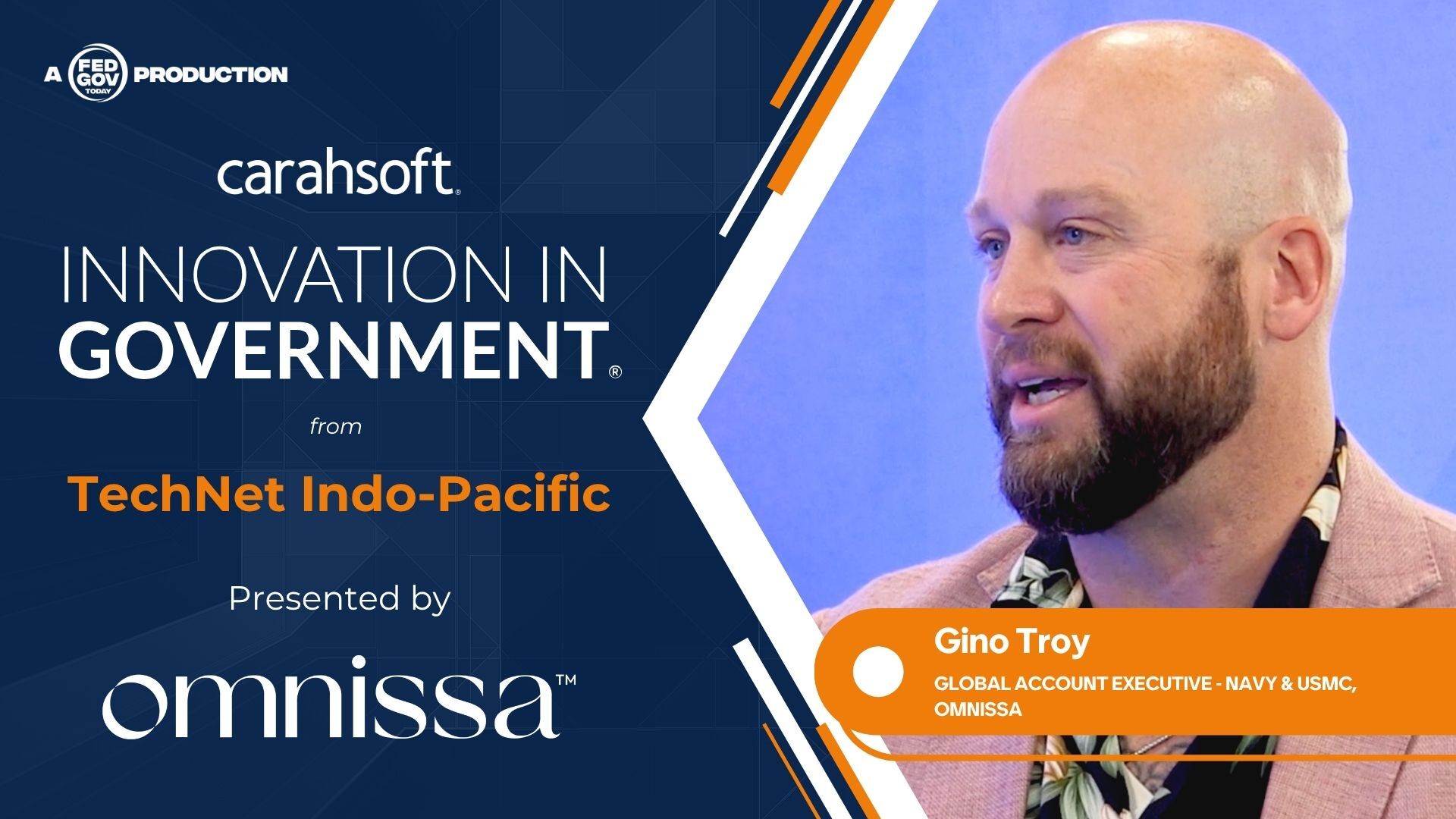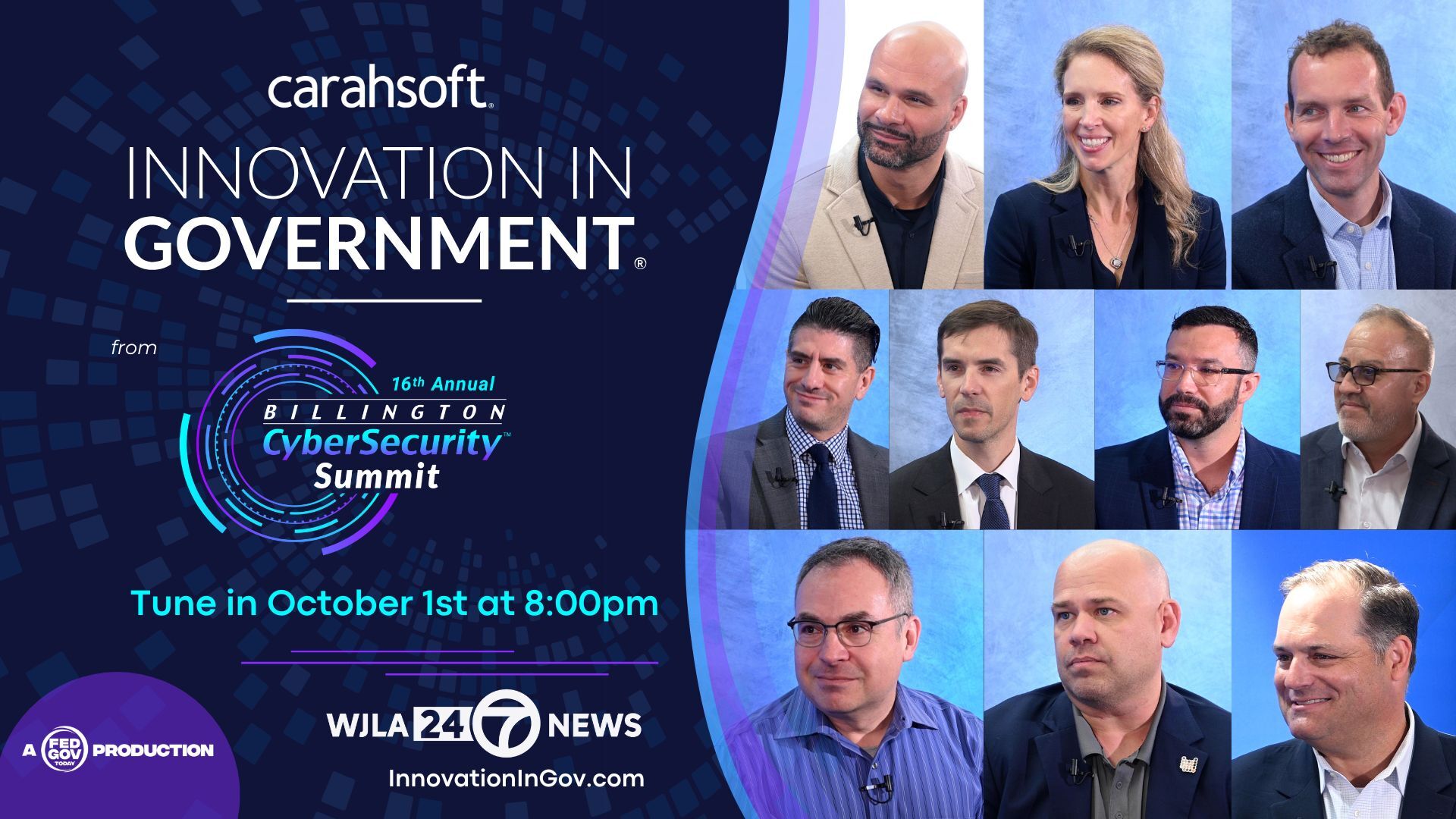Presented by Carahsoft
 Welcome to a special edition of "Innovation in Government," broadcasting from the Sea-Air-Space Exposition 2024, a premier event organized by the Navy League of the United States. This show dives into the latest trends and innovations in maritime, aerospace, and cyber technology that are defining the future of the U.S. Navy, Marine Corps, Coast Guard, and U.S.-flag Merchant Marine. Hosted by Francis Rose, we will explore key advancements in data management, artificial intelligence, and cybersecurity through discussions with leading figures from the U.S. defense industry and military services.
Welcome to a special edition of "Innovation in Government," broadcasting from the Sea-Air-Space Exposition 2024, a premier event organized by the Navy League of the United States. This show dives into the latest trends and innovations in maritime, aerospace, and cyber technology that are defining the future of the U.S. Navy, Marine Corps, Coast Guard, and U.S.-flag Merchant Marine. Hosted by Francis Rose, we will explore key advancements in data management, artificial intelligence, and cybersecurity through discussions with leading figures from the U.S. defense industry and military services.
Shifting Focus in Defense Industry Trends
 Michael McCalip, Vice President, Government Programs and Strategy, Carahsoft discusses the evolving priorities within the defense industry, emphasizing the strategic shifts driven by global challenges and the critical need for rapid capability development.
Michael McCalip, Vice President, Government Programs and Strategy, Carahsoft discusses the evolving priorities within the defense industry, emphasizing the strategic shifts driven by global challenges and the critical need for rapid capability development.
Key Takeaways:
- The defense industry is increasingly focusing on overcoming shortcomings in the defense industrial base to meet urgent naval requirements, particularly in response to geopolitical tensions.
- The impact of supply chain issues remains a significant concern, exacerbated by the pandemic's long-term effects.
- The ongoing need to cultivate a skilled workforce, highlighting the shift towards credentialing over traditional degree-based education as critical to meeting future demands.
Harnessing Speed of Relevance in Naval Warfare
 Peter Reddy, Executive Director, Naval Information Warfare Center Atlantic elaborates on how Naval Information Warfare Center Atlantic contributes to the U.S. Navy's acquisition of capabilities at the "speed of relevance." The Center is pivotal in fostering innovation and developing small-scale technologies that are later adopted widely, enhancing fleet readiness and operational efficiency.
Peter Reddy, Executive Director, Naval Information Warfare Center Atlantic elaborates on how Naval Information Warfare Center Atlantic contributes to the U.S. Navy's acquisition of capabilities at the "speed of relevance." The Center is pivotal in fostering innovation and developing small-scale technologies that are later adopted widely, enhancing fleet readiness and operational efficiency.
Key Takeaways:
- The Center acts as a bridge between fleet operators, program offices, and industry partners, facilitating rapid prototyping and experimentation.
- Emphasis on accelerating program timelines to deliver capabilities to the fleet more swiftly.
- The Center's unique role in leveraging internal R&D for innovation while responding to immediate operational needs.
Advancing Marine Corps Operations through Data-Centric Strategies
 Dr. Colin Crosby, Service Data Officer, USMC Service Data Office and Deputy DON Chief Data Officer discusses the Marine Corps' shift towards a data-centric operational environment, which is integral to reengineering processes and enhancing combat readiness. The focus is on integrating data with AI to boost operational capabilities and decision-making.
Dr. Colin Crosby, Service Data Officer, USMC Service Data Office and Deputy DON Chief Data Officer discusses the Marine Corps' shift towards a data-centric operational environment, which is integral to reengineering processes and enhancing combat readiness. The focus is on integrating data with AI to boost operational capabilities and decision-making.
Key Takeaways:
- Importance of creating a data-centric environment for operational effectiveness and strategic decision-making.
- Integration of advanced technologies, such as AI, to enhance the lethality and efficiency of the forces.
- The ongoing efforts to modernize and streamline operations through innovative data use and technological integration.
Driving Sustainability and Security in Data Management
 Melissa Carson, VP & GM, Iron Mountain discusses Iron Mountain’s role in promoting sustainability and security in data management within the military sector, focusing on the lifecycle management of IT assets.
Melissa Carson, VP & GM, Iron Mountain discusses Iron Mountain’s role in promoting sustainability and security in data management within the military sector, focusing on the lifecycle management of IT assets.
Key Takeaways:
- Iron Mountain's initiatives help the military and government agencies securely manage and recycle IT assets, reducing environmental impact.
- The challenge of balancing cybersecurity with other priorities and the importance of secure data disposal to prevent breaches.
- The role of digital transformation in transitioning from paper to digital media, ensuring data security throughout the process.
Transforming Supply Chain Resilience in the Defense Sector
 Jennifer Bisceglie, Founder and CEO, Interos emphasizes the evolving dynamics of supply chain management in the defense industry, highlighting the critical need for robust, transparent, and resilient supply chain systems.
Jennifer Bisceglie, Founder and CEO, Interos emphasizes the evolving dynamics of supply chain management in the defense industry, highlighting the critical need for robust, transparent, and resilient supply chain systems.
Key Takeaways:
- The increased focus on supply chain vulnerabilities has become a strategic priority, driven by recent global events and the necessity for timely fulfillment of defense contracts.
- The segmentation of supply chain risks into categories like financial, cybersecurity, and geopolitical risks, requiring comprehensive management strategies.
- The importance of continuous monitoring and agile responses to supply chain disruptions to maintain operational readiness and security.
Integrating Cutting-Edge Data Systems in Naval Operations
 VADM Karl Thomas, Deputy Chief of Naval Operations for Information Warfare, N2N6/ Director of Naval Intelligence highlights the strategic importance of the Combined Joint All Domain Command and Control system in enabling effective multi-domain operations. His insights reflect the critical nature of seamless data integration and interoperability among U.S. and allied forces.
VADM Karl Thomas, Deputy Chief of Naval Operations for Information Warfare, N2N6/ Director of Naval Intelligence highlights the strategic importance of the Combined Joint All Domain Command and Control system in enabling effective multi-domain operations. His insights reflect the critical nature of seamless data integration and interoperability among U.S. and allied forces.
Key Takeaways:
- The crucial role of data in maintaining competitive advantage and operational cohesion in multi-domain environments.
- The need for robust, secure data systems that can support complex, long-range operations and strategic decision-making.
- His perspective on the integration of new technologies and data systems within naval operations to enhance global maritime security.
Accelerating Zero Trust Implementation in DoD
 Conrad Maiorino, Cybersecurity Mission Engineer, U.S. Public Sector, Zscaler advocates for an expedited approach to adopting zero trust architectures within the Department of Defense, arguing that the original 2027 target is too distant given the agile capabilities of adversaries.
Conrad Maiorino, Cybersecurity Mission Engineer, U.S. Public Sector, Zscaler advocates for an expedited approach to adopting zero trust architectures within the Department of Defense, arguing that the original 2027 target is too distant given the agile capabilities of adversaries.
Key Takeaways:
- The necessity for the DoD to adapt quickly to cybersecurity innovations and implement zero trust principles ahead of the 2027 goal.
- The potential benefits of leveraging industry practices to enhance cybersecurity measures.
- The importance of making agile and strategic decisions to protect critical information and infrastructure from sophisticated threats.
Cybersecurity at the Forefront of Coast Guard Operations
 RADM Jay Vann, Commander, U.S. Coast Guard Cyber Command outlines the Coast Guard's cyber priorities, which include protecting the maritime transportation system and ensuring the security of U.S. ports. This dual approach not only safeguards economic interests but also bolsters national security.
RADM Jay Vann, Commander, U.S. Coast Guard Cyber Command outlines the Coast Guard's cyber priorities, which include protecting the maritime transportation system and ensuring the security of U.S. ports. This dual approach not only safeguards economic interests but also bolsters national security.
Key Takeaways:
- The role of cybersecurity in protecting the integrity of the U.S. economic and military power projection capabilities.
- Strategies for defending against cyber threats in maritime and port operations.
- The importance of collaborative efforts with other branches and agencies to enhance cyber resilience and response capabilities.
Leveraging Data for Strategic Defense Acquisitions
 Louis Bergeron, SVP Navy, Govini discusses how Govini utilizes data analytics to enhance decision-making processes in defense acquisitions, particularly focusing on optimizing supply chain efficiency and resource allocation.
Louis Bergeron, SVP Navy, Govini discusses how Govini utilizes data analytics to enhance decision-making processes in defense acquisitions, particularly focusing on optimizing supply chain efficiency and resource allocation.
Key Takeaways:
- The strategic application of data analytics to improve visibility and management of the defense supply chain.
- The importance of breaking down data silos within the government to enhance interoperability and efficiency across different programs and services.
- How data-driven insights can inform procurement and supply chain decisions, enabling more effective and strategic resource allocation.
Navigating the Modernization Journey in the Coast Guard
 Brian Campo, Acting Assistant Commandant for C4IT (CG-6) and Deputy CIO, U.S. Coast Guard discusses the Coast Guard’s ongoing journey towards digital modernization, focusing on the development and integration of software solutions to streamline operations and enhance service delivery. Campo highlights the establishment of an operational Software Factory as a key milestone, enabling more dynamic and consistent application deployment.
Brian Campo, Acting Assistant Commandant for C4IT (CG-6) and Deputy CIO, U.S. Coast Guard discusses the Coast Guard’s ongoing journey towards digital modernization, focusing on the development and integration of software solutions to streamline operations and enhance service delivery. Campo highlights the establishment of an operational Software Factory as a key milestone, enabling more dynamic and consistent application deployment.
Key Takeaways:
- Software Factory as a Milestone: The creation of an operational Software Factory allows for consistent and dynamic software deployment, marking a significant advancement in the Coast Guard’s IT capabilities.
- Customer-Centric Development: Emphasizing the importance of aligning software development with customer needs to ensure that solutions meet operational demands effectively.
- Iterative Delivery and Feedback: The focus on iterative development and regular feedback to adapt quickly to changing requirements and ensure that the software continuously meets the evolving needs of Coast Guard operations.
Fostering Innovation Through Strategic Engagements
 Kedar Pavgi, National Capital Region Director (CIV) & Acting Strategic Engagements Director, National Security Innovation Network, DoD elaborates on the National Security Innovation Network's role in connecting cutting-edge technologies and innovative solutions with DoD challenges. Pavgi discusses the importance of creating accessible pathways for startups and academic institutions into the defense innovation ecosystem and the efforts to scale technologies to meet broad DoD needs effectively.
Kedar Pavgi, National Capital Region Director (CIV) & Acting Strategic Engagements Director, National Security Innovation Network, DoD elaborates on the National Security Innovation Network's role in connecting cutting-edge technologies and innovative solutions with DoD challenges. Pavgi discusses the importance of creating accessible pathways for startups and academic institutions into the defense innovation ecosystem and the efforts to scale technologies to meet broad DoD needs effectively.
Key Takeaways:
- Creating Entry Points: Establishing clear and accessible entry points for startups and academic institutions to engage with the DoD, facilitating smoother introductions and partnerships.
- Addressing the Valley of Death: Focusing on overcoming the common challenge of transitioning from initial contracts to sustainable, scalable deployments within the defense sector.
- Collaborative Network Expansion: Expanding the innovation network to include a broader range of stakeholders, ensuring that a diverse array of solutions is available to address specific DoD challenges effectively.



